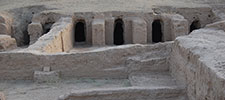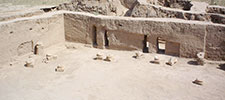The cult complex of Koratepa
To the northwest of Old Termez., on the left bank of the Amu Darya river, there is a three-head l hill. The local people call it Koratepa, which means "Black Hill". From its southern, the highest l.point one can clearly observe the citadel, surrounded by walls, and the ruins of the ancient town. The first archeological excavations took place at Koratepa in 1936. They proved that centuries-old loess cultural layers hide a temple complex with care monastery, founded by Buddhist monks I at the end of the 1st century.
In the underground chambers archeologists found fragments of statues of Buddha and Bodhisattvas. statuettes of dragons and of a winged lion, as well as wall paintings \vith one of the world's oldest images of Buddha surrounded by monks. On the same walls there are portraits of donators, who were rich enough to order the construction of the temple. In the cells there were found ceramic lamps, reliquary boxes, coins of the times of Kanishka I and the Sassanid rulers. Koratepa complex also had a vihara ('dwelling' in Sanskrit) - a dormitory, where pilgrims could take shelter. The walls of this dormitory bear the surviving graffiti picture of a Buddhist stupa.
The Chinese monk Xuan Zang, who made a pilgrimage to India early in the 7th century in search of holy Buddhist books, mentioned his visit to shrines of Koratepa in his famous travelogue "Records of the Western World". Over the last ten years Uzbek and Japanese experts have done joint archeological research at Koratepa.

